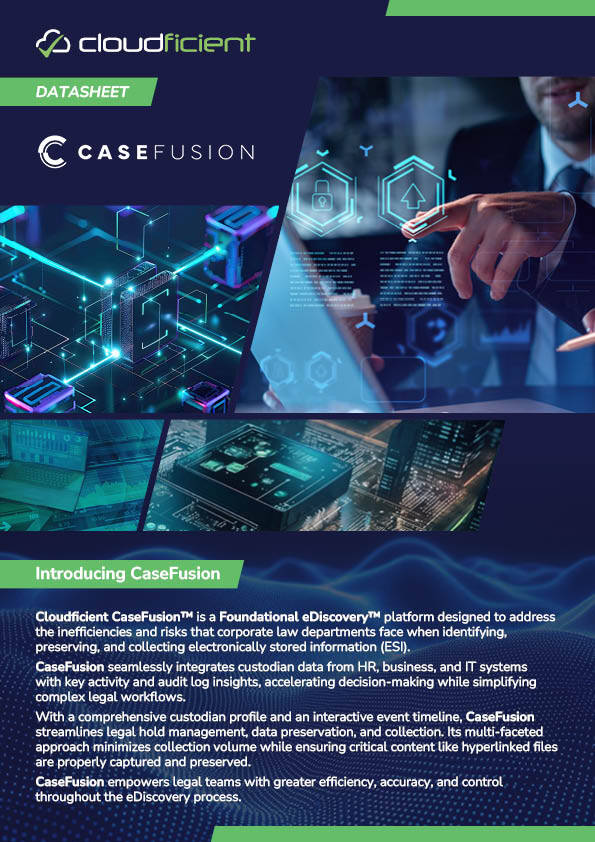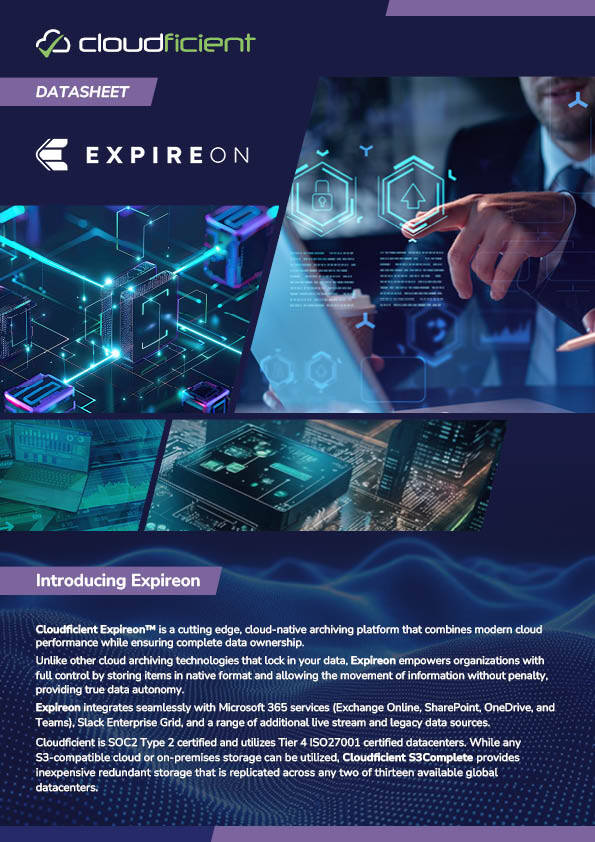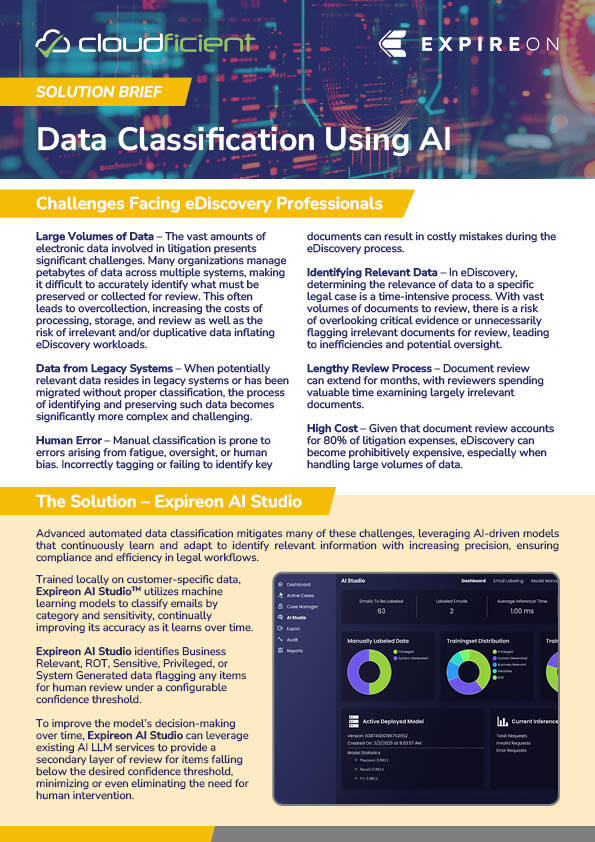- Solutions
- Information Governance
- Legacy Systems Data Management
Legacy System Dependencies Complicate Data Management
Relying on legacy systems holds organizations back by hampering business agility, inflating costs, and exposing them to compliance failures. Outdated platforms trap critical data, lack modern security protocols, and lock enterprises into costly vendor dependencies. Without modernization, legal teams face rising eDiscovery costs due to inefficient processes, rising maintenance fees, and a growing number of operational and technical vulnerabilities.
Security Vulnerabilities and Compliance Failures
Old systems fundamentally lack the security design to protect sensitive enterprise data in today’s threat landscape. These outdated platforms create significant risks that compound over time, particularly as regulatory scrutiny intensifies across industries. Organizations face mounting compliance challenges including:
-
-
Outdated encryption and security protocols: Old IT systems often rely on depreciated security standards that leave sensitive data exposed to modern cyber threats, creating liability risks that extend throughout the organization.
-
Fragmented monitoring and incident response: Without the real-time monitoring, automated alerts, and integrated incident responses that are a part of any modern cloud infrastructure, many platforms lack key capabilities and rely heavily on manual efforts.
-
Non-compliant data storage practices: Outdated platforms rarely meet regulatory requirements for data protection, encryption, and audit trails.
-
Regulatory intolerance in key industries: Financial services, healthcare, and pharmaceutical companies face strict oversight, with auditors demanding immediate access to data, metadata, and audit logs; Information which many legacy systems cannot provide.
-


Maintenance and Licensing Costs
Maintenance costs tend to escalate dramatically as vendor support diminishes and organizational expertise disappears. Old systems require increasingly specialized knowledge that is becoming scarcer and (especially when 3rd parties are involved) more expensive over time. This creates operational risks like:
-
Over-paying for obsolete technology: Organizations are paying for outdated systems that impact business operations with declining performance and reliability issues.
-
Disappearing institutional knowledge: As SMEs and system administrators retire or leave, critical system expertise vanishes, making future maintenance and data access more difficult and costly. Newer employees do not have the time to acquire this knowledge, and often struggle with old operating systems and server applications.
-
Limited vendor support options: Reduced vendor support creates dependency on expensive third-party maintenance contracts with limited responsiveness and expertise. Legacy vendor mergers and acquisitions have the potential to increase this problem dramatically.
Data Accessibility Barriers
Critical business information that is trapped in legacy systems cannot be integrated into other workflows or be accessed efficiently. These accessibility barriers prevent you from leveraging their data assets while creating operational inefficiencies like:
-
Trapped business data: Essential information locked in these systems becomes increasingly difficult to access for eDiscovery, audits, and business intelligence initiatives.
-
Integration failures: Platforms cannot connect with modern business applications, forcing organizations to continue maintaining parallel systems.
-
Manual data extraction: Accessing data requires time-intensive manual labor that delays legal responses and business decisions.
-
Limited search and discovery capabilities: Integrated tools lack modern search functionality making data identification and collection inefficient and error-prone.


Inefficient eDiscovery Processes
Old technology complicates litigation readiness by making data identification, preservation, and collection processes difficult. Home-grown processes to deal with these steps are often manual, time-intensive, and error-prone.
These inefficiencies and reliability issues create spoliation risks, defensibility concerns and inflate legal costs with:
-
Complex custodian identification processes: Systems scatter custodian information across multiple platforms, making comprehensive data mapping difficult, while increasing the risk of incomplete collections.
-
Manual preservation: Manual legal hold processes require extensive interaction between HR, IT and 3rd party resources like LSPs and Outside Counsel. This regularly creates delays and increases both the costs and risks of spoliation claims.
-
Inconsistent collection: Legacy system limitations force different collection approaches across matters, undermining consistency and defensibility.
-
Elevated review costs: Inefficient data collection often results in over-collection, greatly increasing downstream review expenses. A modern, targeted approach can often reduce the overall cost of a case by up to 50%.
Vendor Lock-In and Data Hostage Situations
Vendor dependencies are created through proprietary formats and expensive export processes. This limits both organizational flexibility and increases long-term costs.
These lock-in scenarios prevent a timely response to changing business needs like:
-
Proprietary data formats: Formats that require vendor tools to access and are often expensive to export, creating ongoing dependency relationships, while inherent data growth makes a future migration economically nonviable.
-
Escalating per-user licensing costs: Many software providers have moved to a per-user licensing model, creating unpredictable cost escalation as organizations grow, and (unlike capacity-based licensing models) create licensing issues for employees who have left the organization.
-
Expensive data export: Vendor-controlled export fees make data migration costly and complex, effectively holding organizational data hostage. With data extraction fees of up to $9500 per TB it is critical to monitor the impact and prevent further growth as soon as possible.
-
Limited flexibility: Proprietary formats and vendor restrictions make it difficult to evaluate alternative platforms or respond to changing business requirements. Modern systems can transparently move between storage options like S3 or Azure BLOB storage, while legacy platforms often need traditional file systems with classic backups and maintenance.


Limited Integration Capabilities
Legacy platforms cannot support modern business workflows or integrate effectively with current technology stacks, creating operational inefficiencies that compound over time. These integration failures force you to maintain costly parallel systems or abandon IT modernization & business integration projects resulting in:
-
Fragmented data management: Platforms operate in isolation from other business applications, creating disconnected workflows that require manual intervention and reduce operational efficiency.
-
Performance degradation and system reliability: Aging infrastructure struggles to maintain consistent uptime and response times, that impact critical business operations and user satisfaction.
-
Limited scalability for growing data volumes: These systems cannot handle modern data types like Teams chats and cloud-native communications in a meaningful format like RSMF, creating coverage and data fidelity gaps.
-
Reduced productivity: Personnel need to navigate between traditional and modern systems to complete tasks, reducing efficiency and increasing training requirements.
Develop a Comprehensive Data Migration Strategy
Create a strategic roadmap for legacy system modernization that prioritizes critical business systems while ensuring data integrity throughout the migration process. Comprehensive data migration strategies minimize business disruption by establishing clear timelines and validation checkpoints for each phase. Effective modernization requires detailed planning, ideally in close conjunction with a proven migration specialist firm, covering both the technical requirements as well as operational continuity to ensure successful transformation of digital assets.
Implement Cloud-Native Archiving
Modern cloud-native platforms that provide scalable data archiving with complete data ownership and seamless integration capabilities. Cloud-native archiving eliminates the limitations of traditional systems by offering modern security protocols, unlimited scalability, and native integration with Microsoft 365 and other collaboration platforms. Effective data management solutions provide comprehensive data archiving without vendor lock-in or expensive export processes.
Automated Data Classification and Data Governance
Leverage AI-powered classification systems to automatically categorize legacy data and determine the sensitivity, business relevance, and retention requirements of each item, Automated classification reduces manual effort while improving compliance readiness and eDiscovery efficiency through consistent data categorization. Modern data management platforms should continuously learn from your data to improve classification accuracy over time.
Seamless Integration with Modern Platforms
Deploy legacy system modernization solutions that integrate natively with Microsoft 365, Slack, Teams, and other modern communication platforms to enable unified data management. Seamless integration eliminates data silos by connecting legacy data with corresponding business systems through standardized APIs and modern connectivity protocols. Comprehensive integration capabilities should support both legacy data migration and ongoing data archiving across the organization.
Implement Proactive Legal Hold and Preservation Capabilities
Establish automated preservation workflows that can rapidly identify, preserve, and collect relevant data across legacy systems, providing a modern platform for litigation readiness. Proactive legal hold capabilities reduce compliance risks by ensuring complete data preservation with streamlined collection processes across disparate systems. Effective data management solutions should provide unified legal hold functionality that spans both migrated data and current operational systems.
Complete Data Lineage and Audit Trails
Document all data migration processes with complete audit trails. tracking data sources, transformation steps, and final destinations throughout the modernization process. Complete data lineage ensures defensibility by providing documentation of how data was processed, validated, and preserved during migration. Comprehensive audit capabilities support regulatory compliance and legal defensibility across all data management activities.
Our Solutions
Cloudficient transforms system dependencies through secure data migration, cloud-native archiving, and AI-powered classification that operates at enterprise scale. We deliver complete data ownership without vendor lock-in while providing modern data management capabilities that eliminate the limitations of legacy platforms and enable organizations to modernize their infrastructure without compromising data accessibility or regulatory compliance requirements.
Legacy Migration Services- Fully cloud-native platform that enables data migrations from SourceOne, Enterprise Vault, and PSTs to Microsoft 365. Our migration solutions provide maximum transparency, auditing, and chain-of-custody for everything moved, even during co-existence periods, while reducing risk and facilitating eDiscovery and compliance by liberating data trapped in these systems at enterprise scale.
Expireon - Cloud-native archiving with complete data ownership and no vendor lock-in. Expireon automatically preserves hyperlinked documents referenced in emails or chats to reduce review volumes by up to 40%. Featuring full integration with tools like Microsoft 365 and Slack, Expireon can also onboard data from old archives or acquired companies to consolidate your data into a single platform.
Expireon AI Studio - An AI classification engine that learns on your organization’s data to continuously improve at classifying content based on category and sensitivity. AI Studio identifies Business Relevant, ROT, Sensitive, Privileged, and System Generated data based on configurable confidence settings; uncertain items are flagged for further review. Customers using AI Studio report up to a 33% reduction in review volume.
CaseFusion - Integrated approach to identification through collection by unifying data across HR, IT, and business systems to help legal teams take control of matters early. CaseFusion streamlines or eliminates redundant tasks while improving compliance through smart, integrated workflows, enabling users to find custodians using org charts, schedule interviews, put custodians on legal hold, and preserve their data in M365. The platform can also collect hyperlinked files both as sent and as accessed by receiving custodians.
Frequently Asked Questions
What is a legacy system?
A legacy system is outdated technology infrastructure that companies continue to use despite newer, more efficient alternatives being available. Legacy systems typically lack modern security protocols, integration capabilities, and scalability features required for current business operations. These systems often create data management challenges by trapping critical business information in proprietary formats while requiring expensive maintenance and specialized expertise.
What is cloud data migration?
Cloud data migration is the process of transferring data from legacy systems or on-premises infrastructure to cloud-based platforms. This migration enables organizations to modernize their data management capabilities while eliminating the risks and limitations of outdated systems. Effective enterprise-scale cloud data migrations require specialized tools to ensure business continuity and regulatory compliance.
How does a data management platform work?
A data management platform provides unified capabilities for storing, organizing, securing, and accessing business data across multiple systems and applications. Modern data management platforms integrate cloud-native archiving, automated classification, and intelligent search capabilities to eliminate data silos while ensuring compliance and eDiscovery readiness. These platforms enable organizations to maintain complete control over their data assets while supporting scalable growth and evolving regulatory requirements.
What is legacy data?
Legacy data refers to business information stored in outdated systems or formats that may be difficult to access, migrate, or integrate with modern applications. This data often represents years of critical business communications, documents, and records that companies must preserve for compliance, legal, and operational purposes. Legacy data management requires specialized migration tools and strategies to ensure information remains accessible and usable after modernization occurs.
What is archived data?
Archived data is business information that has been systematically captured, stored, and managed for long-term retention, compliance, and legal discovery purposes. Data archiving ensures that critical communications, documents, and records remain accessible and searchable. Effective data archiving provides unified access to historical business data while supporting eDiscovery workflows and regulatory compliance requirements.
.png?width=620&height=82&name=Untitled%20design%20(18).png)
.png?width=600&height=79&name=Untitled%20design%20(18).png)
-3.png?width=250&height=33&name=Untitled%20design%20(18)-3.png)






